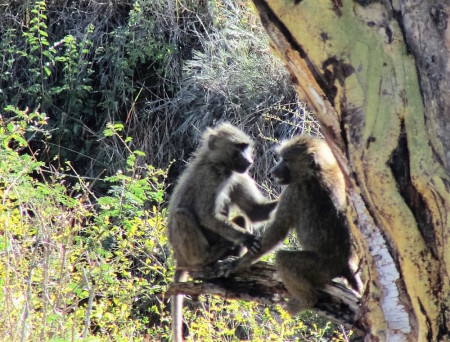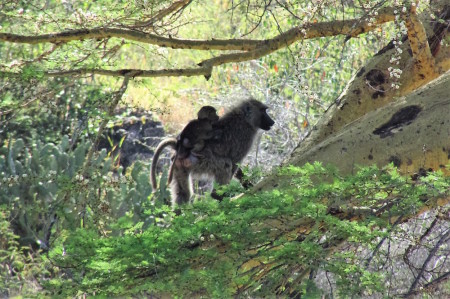Welcome to the Turkana Basin Institute Field School blog. We will post weekly updates of students’ adventures and will also discuss what we are all learning along the way. There are 5 modules over the next 10 weeks- Ecology, Geology, Paleontology, Human Evolution, and Archaeology. Please share with others that might be interested in what the students are up to! In addition, check out the TBI Origins Field School video on our website at http://www.kenyastudyabroad.org/.
Spring 2016 Origins Field School students have started their studies at Mpala Research Centre located in central Kenya, Laikipia county. Here are a few pictures of camp where we have 3 hot meals a day, laundry service, hot showers, and tea time with cake! On top of it all we get to see African wildlife!

Welcoming students to their new home at Mpala Research Camp.

Tents at Ewaso Ngiro River Camp

View from tents

Baboons hanging out in an acacia.

Students enjoying their breakfast together at camp.

Esther, Tobias, Carla, Morgan and Emily hanging out at the fire pit after dinner.
On Friday, students began their studies for the Ecology module instructed by Kenyan entomologist/evolutionary ecologist/conservationist/naturalist and more, Dr. Dino Martins. Our lesson began with an introduction to ecology and evolution, where Dr. Martins brought the students on an expedition to Mukenya (which means Little Mount Kenya) on Mpala Ranch. This was a great way for the students to do some physical activity and work off their jet lag while learning about the ecology of Laikipia at the same time!

Students climb into the lorry ready for their first class in the field!

On our way to Mukenya, we spotted a reticulated male giraffe who so kindly posed for some pictures.

and some elephants!
On the way to class, we passed a group of Grevy Zebras. The Grevy Zebras are the largest and most threatened of the three species of zebra in Africa and are only found in Kenya and Ethiopia. Dr. Martins explained to the students how Grevy Zebras have different stripes and larger ears than other species. They are an endangered species and only 2,350 are left in this world so the students were really lucky to see them!

Group of female Grevy Zebras grazing

Grevy Zebra stallion. While male Plains Zebras tend to stay with the herd, Grevy Zebra males live more solitary lives.

View of Mukenya from the distance.

Students begin their trek up Mukenya!

It looked much easier from the ground until we got to the last section of the hike. I think our legs were really feeling it by the time we got to the top!

Group photo halfway up Mukenya!

First day of class- Dr. Martins discusses the surrounding environment.

Jon searching for elephants at waterholes in the distance

Askaris (soldiers) hanging out at the top during the lesson.

Dr. Martins and his trusty sidekick, Barabara, look out over Mpala.

View from the top.
After class, the students went back out to watch hippos in a nearby waterhole!

Hippos or rocks?

This hippo decided to wait for food to come to her.
At Mpala, there are animals everywhere you look! One of the students rescued a baby mouse and everyone worked together to nurse it back to life.

Kathryn, Jon and Danielle brainstorming on ways to save the baby mouse.

Kathryn feeding the baby mouse milk from a spoon.

Warthogs on Mpala.

Elephants relaxing at a watering hole. We were all very jealous!

Male impala at Mpala.

Young Greater Kudu at Mpala.

A bull elephant, Fido, “befriended” us from across the river at the campsite.
We took Saturday and Sunday off to sleep-in and explore the nearby area, including the town of Nanyuki. Some students visited the equator and local shops for souvenirs, while others chose to participate in the ongoing Laikipia Rabies Vaccination Campaign.

Jon and a young Masai girl helping with the Laikipia Rabies Vaccination Campaign.

Max logging information while helping with the LRVC.

The students visited the equator during their trip to Nanyuki!

On our way to Nanyuki we experienced some friendly traffic.
Check in weekly to see what the students are up to!







